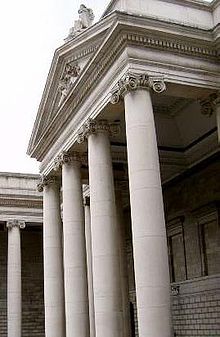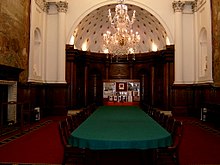Parliament of Ireland
![]()
This article or subsequent section is not sufficiently supported by evidence (e.g., anecdotal evidence). Information without sufficient evidence may be removed in the near future. Please help Wikipedia by researching the information and adding good supporting evidence.
![]()
This article is about the historic Parliament of the Kingdom of Ireland up to 1800; for the present Parliament of the Republic of Ireland, see Oireachtas.
The Parliament of Ireland (Irish Parlaimint na hÉireann, Engl. Parliament of Ireland) was a legislative power in Ireland that existed from the Middle Ages until 1800. It consisted of the King of Ireland and two chambers: the Irish House of Commons and the Irish House of Lords. The House of Lords was occupied by members of the Irish high nobility (Peerage of Ireland), while the House of Commons was directly elected. Over the centuries, Parliament met in various places in and outside Dublin - the first recorded meeting was held at Castledermot in County Kildare on 18 June 1264. Among the meeting places were such famous places as Dublin Castle, Bluecoat School, Chichester House. The last place of assembly was the Irish House of Parliament, built for the purpose, at College Green in the centre of Dublin.

The facade of the Irish Parliament House in Dublin. Today it houses a branch of the Bank of Ireland.
History
The Parliament of Ireland originally came into being in the 13th century as a representation of the Anglo-Norman landlords in Ireland. The original Gaelic inhabitants were not represented or entitled to vote. However, in the 14th and 15th centuries the number of English inhabitants in Ireland fell dramatically - only a small enclave around Dublin, known as the Pale, remained. Parliament therefore became mainly a forum of this enclave until the 17th century. The inhabitants of the Pale then urged the King of England to play a more leading role in Ireland to protect them from the Gaelic-Irish nobles. By the Poynings' Law (1494), the Parliament of Ireland became subordinate to the English Parliament and thus lost power.
The role of the Irish Parliament changed in 1541 when Henry VIII proclaimed the "Kingdom of Ireland" and the re-conquest of Ireland by the Tudors began. The Protestant Reformation of the Tudors and the introduction of the Anglican state church changed the political picture in Ireland, as the majority of the population was still of Roman Catholic denomination, which led to fierce disputes in the Irish Parliament. In 1613 to 1615, therefore, constituencies for Parliament were drawn up precisely so that the English and Scottish settlers constituted the majority of the members of the Irish Parliament. Now the Irish Parliament served - once again - to represent the English, but now Protestant, minority. In the following period, the Anglo-Irish Parliament often tried (unsuccessfully) to achieve independence from London. Then, in the early 18th century, it successfully campaigned to be convened every two years - previously this had been dependent on the whims of the British king - shortly afterwards it even achieved permanent "attendance", a development similar to that of the British Parliament. Furthermore, the Parliament fought for greater powers over the (superior) British Parliament as well as better trading conditions with Great Britain.
Many public ceremonies in Ireland were modelled on the British Parliament. The parliamentary season was officially opened with the Speech from the Throne by the Lord Lieutenant of Ireland, who sat on a throne of purple velvet. During the parliamentary sessions, the wealthiest Anglo-Irish elite moved to Dublin, as this period was often accompanied by balls and festivities. Members of the high nobility in particular flocked to Dublin, where they lived in huge and richly decorated residences - initially in the northern part of Dublin, and later in the new Georgian residences around Merrion Square and Fitzwilliam Square. Their presence in the city helped it to a real economic boom.

The former Upper House Chamber in the Irish House of Parliament. Today a room of the Bank of Ireland branch.
The House of Lords (Irish House of Lords)
The Irish House of Lords was the upper house of the Parliament of Ireland. It also acted as the Supreme Court of the Kingdom of Ireland.
The House of Lords was presided over by the Lord Chancellor of Ireland, who sat on what was known as the 'woollen sack' - a very large chair which had neither arm nor backrest, and whose purple cushion was filled with wool from all three 'lands' of the United Kingdom (England, Scotland, Ireland).
Search within the encyclopedia